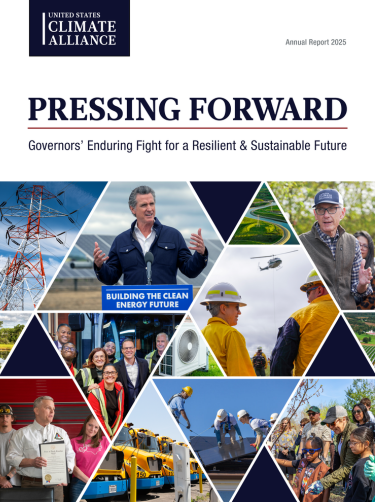Home / 2025 Annual Report | Pressing Forward

The Alliance’s 2025 Annual Report paints a picture of progress and perseverance. It lays out the scientific consensus behind our changing climate, noting the irrefutable fact that greenhouse gas emissions from human activities are the primary driver of this crisis. It shows how Alliance members are moving closer to achieving the coalition’s collective goals, including by cutting GHG emissions by 24 percent while growing their economies by 34 percent between 2005 and 2023. And it demonstrates how the Alliance is building the clean energy and clean technology future — from driving record heat pump and electric vehicle sales to deploying new wind and solar power construction and generation.
Across the United States, state and territories are continuing to take bold action on the climate crisis, from setting new and increasingly ambitious targets and adopting new laws and regulations to investing billions of dollars in climate mitigation projects and advancing new tools and strategies to promote affordability and lower costs.
What Alliance members are doing is delivering real results. And this year, governors in every Alliance state and territory have shown they are built to lead in this moment — and won’t back down. They will keep harnessing the power of collective state-led, high-impact climate action for the health and welfare of current and future generations of Americans.
Slashing Climate Pollution, Growing the Economy
Analysis included in the report, previewed by New York Governor Kathy Hochul and Delaware Governor Matt Meyer during Climate Week NYC, finds that the Alliance members have collectively reduced net greenhouse gas emissions 24 percent below 2005 levels, while increasing their collective GDP by 34 percent. The figures, updated to reflect progress in 2023, continue the coalition’s trend of declining emissions over the last 18 years and put its near-term target of reducing net emissions 26 percent by 2025 within reach. Moreover, compared to the rest of the country, Alliance members are continuing to reduce emissions faster while employing more clean energy workers, achieving lower levels of harmful air pollutants, and executing more pre-disaster planning.
The Alliance’s long-term progress has been driven primarily by the transition to cleaner electricity generation, which has helped cut the coalition’s electricity sector emissions 45 percent as of 2023. This represents an eight percent decrease over 2022 levels — the largest year-on-year reduction in this sector over the last decade, outside of 2020. Emissions from the transportation sector, which remains the Alliance’s largest source of emissions, have also decreased 17 percent below 2005 levels. Of the nation’s registered zero-emission vehicles, 70 percent are in Alliance states, supported by 68 percent of all publicly available EV chargers.
Advancing Action, Transforming Markets
The report also provides hundreds of examples across sectors of how the coalition’s member states and territories are raising ambition, while advancing, sharing, and scaling the most impactful climate solutions. In fact, since launching the Alliance more than eight years ago, members have advanced more than 2,300 bold actions and innovative policies to tackle climate pollution and build resilience to the impacts of climate change. In the last year alone, Alliance members have:
Thanks to these and other efforts, U.S. markets are rapidly transforming toward cleaner technologies and cleaner energy. The nation’s heat pump sales outpaced gas furnaces by 32 percent in 2024 — beating the prior year’s record-setting lead of 21 percent. More than 1.5 million electric vehicles were sold in 2024, more than five times higher than 2020 totals. Nearly two-thirds of electricity generation currently under construction and expected to come online through 2031 will be powered by solar and wind. And by the end of 2024, more than 5 million American households had installed rooftop solar, lowering their electricity costs while strengthening the grid.
Charting a Path Forward, Saving Americans Money
Importantly, the report also identifies a pathway to help mitigate the loss of federal ambition over the coming years. This pathway reflects broad adoption of state-level policy solutions already being developed or implemented in many Alliance states that aim to save households money, cut harmful pollution, and protect communities. What’s more, this analysis finds that transitioning to a net-zero economy by 2050 would deliver significant monetary benefits that vastly outweigh the costs.
In fact, it’s estimated that achieving the Alliance’s collective climate goals could lead to trillions of dollars of cumulative net benefits to Americans over the coming years — growing from $11 billion in annual net savings by 2030 to $103 billion by 2035, and $185 billion by 2050. These savings are based on improved public health, reduced spending on fossil fuels, and avoided climate damages. Notably, the analysis does not include a broad array of additional benefits likely to accrue from achieving net-zero emissions, such as job creation, economic growth, and non-air-quality public health benefits.
Reaffirming the Scientific Consensus
Finally, in the face of attempts by the federal government to deny, obstruct, and hide basic science, this report lays out the clear scientific consensus that greenhouse gas emissions from human activities are the primary driver of the climate crisis. It reaffirms Alliance governors’ commitment to the essential role of science in mitigating climate change and to science-based decision-making in their states.